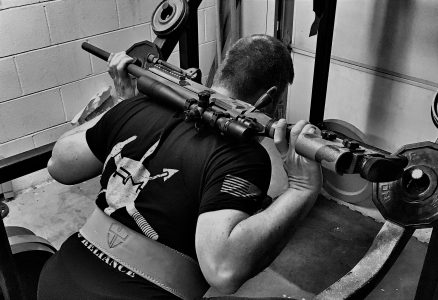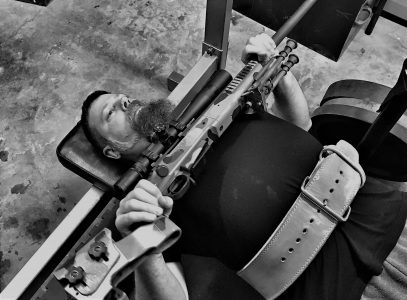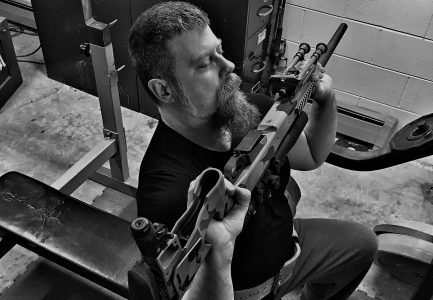Navigate This Post
I have always known how to exercise. We did calisthenics in gym class in elementary school. I played basketball, baseball, and football in Junior High. In High School I truly learned about cardiovascular training when we did the “2 A Day” conditioning practices during the weeks that led up to football season in High School. As a United States Marine, I truly learned what conditioning strength was all about.

With all that being said, it was not until I met Matt Reynolds in January of 2017 and took his “Fight Strong” Class in Camden, Tennessee, that I began to understand what genuine strength training was all about. In High School and again in the Marine Corps, I spent time in the weight room, but I didn’t truly know what I was doing. Like most people, I mimicked what I saw others doing. Over the years I would engage in exercise programs. I would lose some weight, gain cardiovascular endurance and even grow some muscle, primarily in my arms and chest. To use the popular vernacular, my “gains” were sporadic and irregular.

Starting Strength Program
Matt Reynolds introduced me to the Starting Strength program as taught by strength training legend, Mark Rippetoe. Matt’s company, Starting Strength Online Coaching is a training and coaching resource that was developed to give everyone, everywhere, the opportunity to get physically strong.
The Starting Strength program is simple, hard, and effective. All three of those qualities must be present for a person to grow. If a program is simple, but not hard, there will be no long term gains. If a program is complex and hard, the end user will, more likely than not, get frustrated and the likelihood that they will succeed is slim.
Few people can dedicate themselves full-time to physical strength training. With the exception of professional athletes, everyone else has to balance family and career time with strength training time. If you can find a job where someone pays you to get strong, tell Vince McMahon I said hello.
The Beginner’s Linear Progression program, which is the entry level of Starting Strength, includes only 4 individual barbell exercises. That’s it, only 4 lifts. The trick is that each lift needs to be completed to an absolute standard. It is not enough to simply push weight in a sloppy or haphazard manner.
From the very start, your SS coach will critique every aspect of you movement; foot placement, grip, stance, back set, head and neck position, everything. When you begin, it’s natural to think that you have been lifting correctly, but more often than not, no one has ever critiqued you like an SS coach.
Would you like to be part of our private community of like-minded individuals?
CLICK HERE to apply to be part of The Student Lounge.
Poor to Acceptable, Acceptable to Okay, Okay to Good
When you begin, your form will most likely be poor, at least by Starting Strength standards. That’s alright. If you are a good student, you should move to acceptable in a few weeks. From there your coach may give you guarded praise, such as “that was okay, but…” Take that praise and run with it. When you SS coach eventually says, “those were good, but…” you know you are on the right track.
Most people who attempt to engage in strength training are self-taught or they take their cues from someone else at the gym. Having a professional strength training coach critique your form is a humbling experience. Humble yourself and take the criticism.
For adult men, taking criticism, even from a professional trainer, can be extremely difficult. It requires us to park our precious egos. That is one of the reasons so many will fail. They can’t shut their mouths and listen.
Marksmanship Parallels
I have been coaching and teaching long range rifle marksmanship since 1990 when I attended USMC Rifle and Pistol Coaches School. In the decades since then, I have trained thousands of people in the use of a rifle.
With very few exceptions, the majority of people who I trained arrived with the feeling that they were already “pretty good” with a gun. However, loading a rifle and pressing the trigger is not marksmanship. That is just making noise. Similarly to strength training, men will go to a gym and pick up weights thinking that they know what they are doing, because they are men.
In order to hit a target at distance, with a single shot, on demand, you need to follow several simple, but critical steps. The fundamentals of marksmanship can be explained in one classroom session, but getting a person to apply them, every single time they press the trigger, is something entirely different.
Again, I’m not talking about loading up a magazine and blasting away until you eventually hit the target. What I mean is getting behind a rifle and putting a single shot onto a target that may be hundreds of yards away.
Performing a Starting Strength barbell lift exactly as your coach has instructed requires a tremendous amount of concentration and self-discipline. As a coach, I can tell you and show you what you need to do, but I cannot get behind the rifle and make you do it. The same goes for strength training, you have to make yourself do it. The coach cannot lift the barbell for you.

All Those Steps
Of all the barbell lifts that Starting Strength uses, the squat is the most important and the most difficult to master. Again, most people who have been in a weight room erroneously believe they already know how to squat. To execute a correct squat you need to focus on the bar placement, your hand position, your head and neck position. Also your foot placement, the Valsalva maneuver (abdominal tension), your back set, knee movement, depth and breath control. And, you need to concentrate on all of these as the barbell is moving. This is no small task.
To hit a target at distance with a single shot from a rifle, you need to focus on your natural point of aim, bone support, eye relief, cheek placement, finger placement on the trigger, breath control, sight alignment, trigger press, and follow through. The farther the target, the more critical everyone of those aspects becomes.
Once more, it is not difficult to discuss these step and their importance. It is another thing entirely for the shooter to get behind the rifle and apply each and every marksmanship principle.
Starting Strength coaches will focus on one area per session and attempt to fix it. For instance, during one session they may focus on foot placement. During another they may focus on knee movement or depth. Eventually, the student will master each step until they all come together.
As a marksmanship coach, you take a similar approach. We make the obvious corrections first, finger placement, natural point of aim, cheek placement, etc. If the student is willing to be coached, after a while, they will begin to put it all together.
Tact
While a person may have the physical attributes to one day squat 300 or even 400 pounds, a strength coach will not simply push them to that weight. Instead, they will begin with moderate weight and progress methodically.
No one attends a precision marksmanship course and is put on the 1000 yard target the first day. Instead, we work from 100 yards on out. If the student applies what they have been taught and dedicates themselves to the mastery of the fundamentals, most of them will eventually get out to 1000 yards (with the correct gear).
With Starting Strength, you will video yourself performing the lifts every time. Your coach will critique and you can go back and look at them. For precision marksmanship, we have the shooter fire a slow fire group on paper at 100 yards and keep notes in a notebook. After they have more training and experience, we shoot 100 yards slow fire again and compare the results. Most every student is amazed at their progression. Even the ones who arrived thinking that they were “already pretty good” are impressed by their “gains”.
After a few months of SS coaching, when you go back and watch your lifting videos, it is an eye opening experience. What you thought was “pretty good” now seems like amateur hour.
Mind and Body
This Starting Strength program is something I have been involved in and have been professionally coached for about 15 months as these words go to paper. I have absolutely seen real “gains” and have successfully moved from the Beginner’s Linear Progression to the Intermediate Program.
As someone who has been teaching precision marksmanship for going on three decades now, I am continuously amazed at all of the parallels between the two endeavors. It has not just been the teaching and coaching principles that are similar, but the progression that the students must go through in order to achieve success.
Precision marksmanship is viewed by most outsiders as a physical undertaking. They see the movements and action, but not the mental aspect. In truth, the physical part of marksmanship is the easy part, it is the mental process that is the most difficult to master and the most important.
Regarding strength training, most people have within them the physical potential to become strong and move the weight. Where they will fail is exercising the mental discipline to force their body to do what is required.
That is the truest test of strength. Just as a marksmanship coach can explain and demonstrate all that is needed to hit the target. He cannot get behind the rifle and make the shot for you. Your strength coach can and will explain and demonstrate how to move the barbell, but it is you who must get under the weight and move it.
For more info, go to studentofthegun.com/ssoc
Professor Paul Markel
Latest posts by Professor Paul Markel (see all)
- Tactical Masturbation: Top 3 Stupid Human Tricks - July 8th, 2024
- Blood Trail: Fearless Fiction - June 21st, 2024
- SOTG and SB Tactical Celebrate Brace Ruling - June 20th, 2024
- Shotgun Accessories: Practical and Useful - June 14th, 2024
- Tactical Rifle Tips: Transition Drills - January 5th, 2024






That is a fantastic article. Nothing worthwhile is every easy. Knowing I have a long way to go, in more than one area is daunting, but not as daunting as it was when I first got started. This being a “student” business is alright. Thanks for blasting away a trail for others to follow.